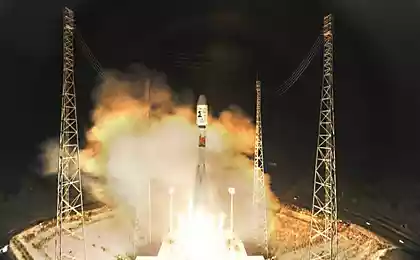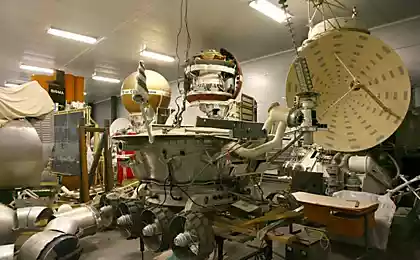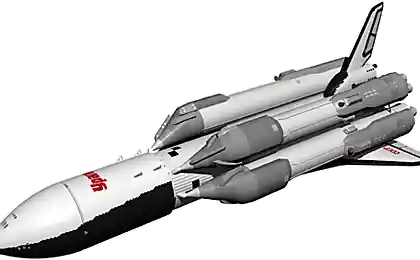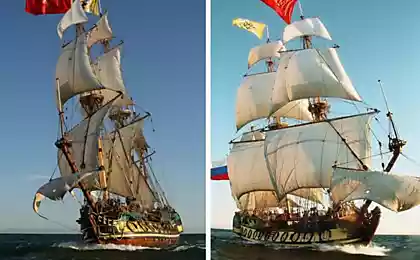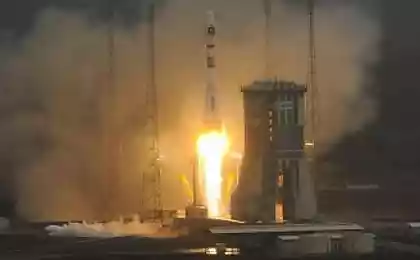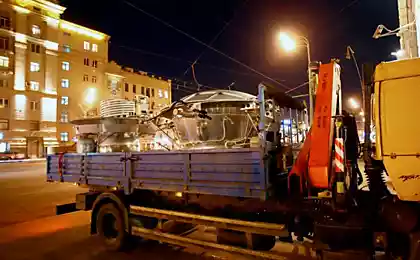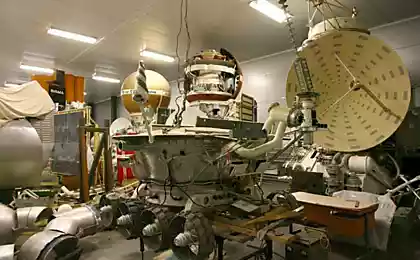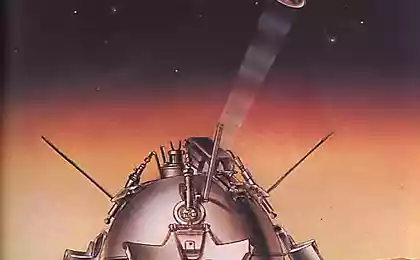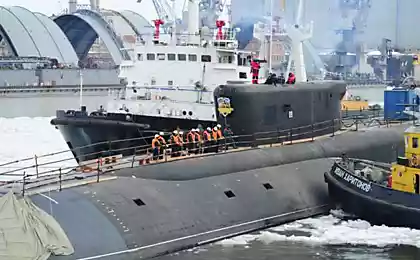875
Interorbital tug
Interorbital tug - Listen to this phrase. From it emanates a certain commonplace future. Like the tug - it's something utilitarian, simple, just between the orbits. Space steamer that drags space ships ...
I do not know what considerations were the developers when they renamed the upper stage "Fregat" in interorbital tug, but the wording is chosen exceptionally well. After all, what is a "booster"? So, just another part of the rocket, upper stage of Western terminology - "top level". While "interorbital tug" - an independent spacecraft that performs complex tasks with high precision and in a short time. As you have seen, today's talk about interorbital tug "Fregat" production NPO. SA Lavochkin.
Its name "frigate" was no accident, in the first letter of the name kept the memory of the precursor from which the tug was developed. "Grandpa Frigate" is interplanetary station "Phobos", which was the last attempt of the Soviet Union to conquer Mars and last interplanetary missions of our country, which achieved at least partial success.
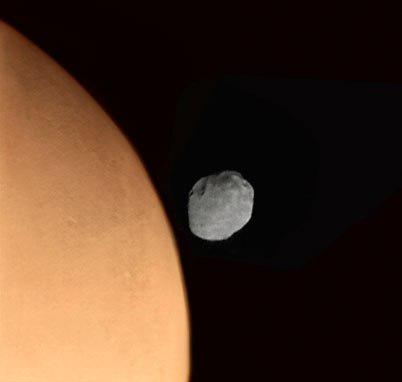
How much of the space program, "Frigate" - a talented compromise between the needs, capacities, timing and cost of the product. For 14 years, he has shown the vision of designers and extensive modernization, greatly expanding the range of applications.
The use of spherical fuel tanks NPO Lavochkin happened since the lunar missions. If you look under the "Lunokhod" can be seen sphere. "Phobos" flew in the layout, which has already seen the tug of the future.
A similar fuel compartment and was tragically killed in the "Mars-96».
"Frigate" is created in response to growing market demand for the launch of several satellites into different orbits. This proved necessary for GLONASS and for many commercial orders Roscosmos and later and Arianspace.
When creating interorbital tug went the way of maximizing the opportunities for industry and Euclidean geometry. Fuel tanks have concluded in the scope of how to form the most effective ratio of useful volume and mass. Rival Torus scheme has lost in this comparison.
In the "Fregat" many interesting engineering solutions that delight its practicality and elegant simplicity. As you can see, based on the tug are six spherical tanks, two of which - under the fuel, oxidizer and two under two - contain management system.
Oxidizer takes more than fuel, so the tanks with nitrogen tetraksidom deepened in the tank with asymmetrical dimethylhydrazine.
The control system borrowed from the rocket "Zenith", produced by FSUE "Scientific-Production Center of Automatics and Instrument. Academician NA Pilyugina. " The system is implemented on legacy, hermetic principle, ie, Electronics hidden inside an aluminum "aquarium." But a conscious decision: leaky exit scheme harder. The practical difference between them is only one: a sealed unit may be damaged as a result of loss of pressurization, for example due to falling micrometeorite or space debris. This danger exists for long-lived plants, and for "Frigate", who lives a few hours or a day, this danger is minimal.
Boosters chosen brand S5.92 production "KB Chemical Engineering. AM Isaev "pull up to 2 tons. Although the choice of toxic fuel components are not popular among the champions of the environment, but from a practical point of view, is the best choice, providing the highest efficiency for chemical engines. After refueling, lift can wait two months before the launch, which would rule out, whether it is on the "green" kerosene and oxygen.
Except for one cruise on the "Fregat" found another 12 engines orientation and roll control. These one-component hydrazine, i.e. they do not require an oxidant, and reaction gas evolution occurs at the contact of fuel and a chemical catalyst.
Spherical tanks are effective in a ratio of weight / volume, but even before the designers had a task to transfer the load from the missile to the satellites. Without additional support structure, interorbital tug during the launch would have been crushed between the missile and the launch manifest. The easiest way out - make fuel tanks in the power frame, but it significantly increases the weight and dimensions. The solution found is technologically more complex but more effective - "Please" tanks carrying rods.
I create "Frigate" in the '90s with the future in a rocket "Soyuz-2" with a digital control system. But when it became clear that the work on the tug ahead of the establishment of the missile, the designers have taken care of possibilities starts with the analog "Union».
For this NGO Lavochkin had to develop their own design fairing. As a result, in such an arrangement it was launched interplanetary spacecraft of the European Space Agency Mars Express and Venus Express in 2003 and 2006 respectively. So "Frigate" became the most distant messengers of modern Russia in space.
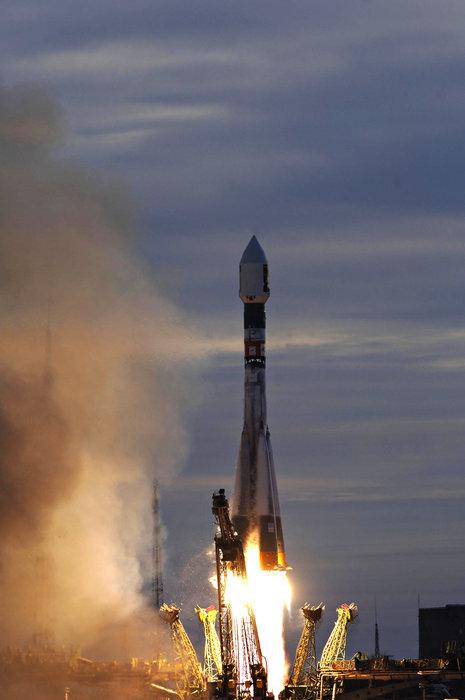
Since the beginning of operation "Soyuz-2" became the obvious need to expand the possibilities of "Frigate" by increasing the volume of tanks. This was achieved by installing additional tanks of different sizes. So get increased supplies of fuel from 5250 kg to 7100 kg, and change them depending on the task.
Curious history of the emergence modification "Fregat-MT." In 2003, Russia signed an agreement with the European Space Agency on joint use of Kourou in French Guiana. ESA just did not have enough medium-range missiles, and a new version of "Union" was very helpful. But the Europeans had one condition - the spent rocket stage should not reach the outskirts of Europe and sinking in the Atlantic. NPO Lavochkin skilled had to develop a separate arrangement with the tanks to 6600 kg of fuel to lift could take the baton before. Since then, the "Fregat-MT" flew nine times from another continent.
But the top career interorbital tug steel launches into geostationary orbit, a rocket "Zenit". Such "Frigate" is not prepared, this orbit is too high: it was initially assumed to operate only on the "Union", and GSO have previously flown only "Proton". To carry out an impossible mission "Fregat" added the three-ton drop tank and filled fuel weight was adjusted to 10 to 25 tons.
"Fregat-SB" (drop tank) flew twice in the interests of national cosmonautics: put the satellite "Electro-L" on the geostationary orbit and astrophysical radio observatory "Spektr-R" on high-elliptical orbit with a height of up to 340 thous. Km - almost to the Moon . "Electro-L" is known for its many photographs of the Earth, but now shooting stopped due to a fault in the system of orientation, and the satellite continues to operate repeater in the interests of Roshydromet. "Spektr-R" fourth year continues to work within the framework of the project "Radioastron" - is in fact the most powerful radio telescope in the world. Both satellites also developed NGO Lavochkin. Now it is preparing for the launch of "Electro-L 2».
Since its first launch in 2000, "Frigate" carried out 45 successful launches. Several times there have been failures on him, but he still pulled a payload on the remains of fuel. In 2009 there was a case when the third stage of the rocket on the program unfinished and "Fregat" had to take the rap for themselves and for the guy. The satellite "Meridian-2" to the desired orbit and has not reached, but retains the possibility of partial operation.
Recently, on July 8, "Frigate» brought 7 satellites at a time, one primary "Meteor-M2" and six small devices, including Russian private DX1. During this flight, "Frigate" even got a video from one of the satellites TechDemoSat-1.
26 seconds i>.
A 3 April 2014, at the insistence of the French side, the rocket "Soyuz" with the satellite Sentinel-1A equipped with video cameras to record the entire process run from the start to the separation of the spacecraft. There "Fregat" plainly be seen, but still a video worth viewing.
Only last Friday, the forty-sixth flight, an error occurred in the stage of "Frigate" - a pair of European navigation satellites Galilleo not reached the target orbit. Now there is an investigation, and early to talk about the causes of failure and the extent of the damage can not yet be certain even argue that the fault lies with "Fregat". However, the fact remains blunder that occurred on the stage of the interorbital tug and possibly, it leads to loss of satellites.
Despite the failure of August 22 "Fregat" remains one of the most reliable in Russia and the world. Its competitiveness is confirmed by long-term operation of foreign aerospace giant Arianspace. The potential of "Frigate" can be considered as the basis for unmanned interplanetary probes, and as an auxiliary tool for manned flight to the moon .
When preparing the materials used:
«Bulletin NPOL» (there is still a lot of things on ballistics, systems, heat, control, communications)
russianspaceweb.com i>
Source: habrahabr.ru/post/234431/
I do not know what considerations were the developers when they renamed the upper stage "Fregat" in interorbital tug, but the wording is chosen exceptionally well. After all, what is a "booster"? So, just another part of the rocket, upper stage of Western terminology - "top level". While "interorbital tug" - an independent spacecraft that performs complex tasks with high precision and in a short time. As you have seen, today's talk about interorbital tug "Fregat" production NPO. SA Lavochkin.
Its name "frigate" was no accident, in the first letter of the name kept the memory of the precursor from which the tug was developed. "Grandpa Frigate" is interplanetary station "Phobos", which was the last attempt of the Soviet Union to conquer Mars and last interplanetary missions of our country, which achieved at least partial success.

How much of the space program, "Frigate" - a talented compromise between the needs, capacities, timing and cost of the product. For 14 years, he has shown the vision of designers and extensive modernization, greatly expanding the range of applications.
The use of spherical fuel tanks NPO Lavochkin happened since the lunar missions. If you look under the "Lunokhod" can be seen sphere. "Phobos" flew in the layout, which has already seen the tug of the future.
A similar fuel compartment and was tragically killed in the "Mars-96».
"Frigate" is created in response to growing market demand for the launch of several satellites into different orbits. This proved necessary for GLONASS and for many commercial orders Roscosmos and later and Arianspace.
When creating interorbital tug went the way of maximizing the opportunities for industry and Euclidean geometry. Fuel tanks have concluded in the scope of how to form the most effective ratio of useful volume and mass. Rival Torus scheme has lost in this comparison.
In the "Fregat" many interesting engineering solutions that delight its practicality and elegant simplicity. As you can see, based on the tug are six spherical tanks, two of which - under the fuel, oxidizer and two under two - contain management system.
Oxidizer takes more than fuel, so the tanks with nitrogen tetraksidom deepened in the tank with asymmetrical dimethylhydrazine.
The control system borrowed from the rocket "Zenith", produced by FSUE "Scientific-Production Center of Automatics and Instrument. Academician NA Pilyugina. " The system is implemented on legacy, hermetic principle, ie, Electronics hidden inside an aluminum "aquarium." But a conscious decision: leaky exit scheme harder. The practical difference between them is only one: a sealed unit may be damaged as a result of loss of pressurization, for example due to falling micrometeorite or space debris. This danger exists for long-lived plants, and for "Frigate", who lives a few hours or a day, this danger is minimal.
Boosters chosen brand S5.92 production "KB Chemical Engineering. AM Isaev "pull up to 2 tons. Although the choice of toxic fuel components are not popular among the champions of the environment, but from a practical point of view, is the best choice, providing the highest efficiency for chemical engines. After refueling, lift can wait two months before the launch, which would rule out, whether it is on the "green" kerosene and oxygen.
Except for one cruise on the "Fregat" found another 12 engines orientation and roll control. These one-component hydrazine, i.e. they do not require an oxidant, and reaction gas evolution occurs at the contact of fuel and a chemical catalyst.
Spherical tanks are effective in a ratio of weight / volume, but even before the designers had a task to transfer the load from the missile to the satellites. Without additional support structure, interorbital tug during the launch would have been crushed between the missile and the launch manifest. The easiest way out - make fuel tanks in the power frame, but it significantly increases the weight and dimensions. The solution found is technologically more complex but more effective - "Please" tanks carrying rods.
I create "Frigate" in the '90s with the future in a rocket "Soyuz-2" with a digital control system. But when it became clear that the work on the tug ahead of the establishment of the missile, the designers have taken care of possibilities starts with the analog "Union».
For this NGO Lavochkin had to develop their own design fairing. As a result, in such an arrangement it was launched interplanetary spacecraft of the European Space Agency Mars Express and Venus Express in 2003 and 2006 respectively. So "Frigate" became the most distant messengers of modern Russia in space.

Since the beginning of operation "Soyuz-2" became the obvious need to expand the possibilities of "Frigate" by increasing the volume of tanks. This was achieved by installing additional tanks of different sizes. So get increased supplies of fuel from 5250 kg to 7100 kg, and change them depending on the task.
Curious history of the emergence modification "Fregat-MT." In 2003, Russia signed an agreement with the European Space Agency on joint use of Kourou in French Guiana. ESA just did not have enough medium-range missiles, and a new version of "Union" was very helpful. But the Europeans had one condition - the spent rocket stage should not reach the outskirts of Europe and sinking in the Atlantic. NPO Lavochkin skilled had to develop a separate arrangement with the tanks to 6600 kg of fuel to lift could take the baton before. Since then, the "Fregat-MT" flew nine times from another continent.
But the top career interorbital tug steel launches into geostationary orbit, a rocket "Zenit". Such "Frigate" is not prepared, this orbit is too high: it was initially assumed to operate only on the "Union", and GSO have previously flown only "Proton". To carry out an impossible mission "Fregat" added the three-ton drop tank and filled fuel weight was adjusted to 10 to 25 tons.
"Fregat-SB" (drop tank) flew twice in the interests of national cosmonautics: put the satellite "Electro-L" on the geostationary orbit and astrophysical radio observatory "Spektr-R" on high-elliptical orbit with a height of up to 340 thous. Km - almost to the Moon . "Electro-L" is known for its many photographs of the Earth, but now shooting stopped due to a fault in the system of orientation, and the satellite continues to operate repeater in the interests of Roshydromet. "Spektr-R" fourth year continues to work within the framework of the project "Radioastron" - is in fact the most powerful radio telescope in the world. Both satellites also developed NGO Lavochkin. Now it is preparing for the launch of "Electro-L 2».
Since its first launch in 2000, "Frigate" carried out 45 successful launches. Several times there have been failures on him, but he still pulled a payload on the remains of fuel. In 2009 there was a case when the third stage of the rocket on the program unfinished and "Fregat" had to take the rap for themselves and for the guy. The satellite "Meridian-2" to the desired orbit and has not reached, but retains the possibility of partial operation.
Recently, on July 8, "Frigate» brought 7 satellites at a time, one primary "Meteor-M2" and six small devices, including Russian private DX1. During this flight, "Frigate" even got a video from one of the satellites TechDemoSat-1.
26 seconds i>.
A 3 April 2014, at the insistence of the French side, the rocket "Soyuz" with the satellite Sentinel-1A equipped with video cameras to record the entire process run from the start to the separation of the spacecraft. There "Fregat" plainly be seen, but still a video worth viewing.
Only last Friday, the forty-sixth flight, an error occurred in the stage of "Frigate" - a pair of European navigation satellites Galilleo not reached the target orbit. Now there is an investigation, and early to talk about the causes of failure and the extent of the damage can not yet be certain even argue that the fault lies with "Fregat". However, the fact remains blunder that occurred on the stage of the interorbital tug and possibly, it leads to loss of satellites.
Despite the failure of August 22 "Fregat" remains one of the most reliable in Russia and the world. Its competitiveness is confirmed by long-term operation of foreign aerospace giant Arianspace. The potential of "Frigate" can be considered as the basis for unmanned interplanetary probes, and as an auxiliary tool for manned flight to the moon .
When preparing the materials used:
«Bulletin NPOL» (there is still a lot of things on ballistics, systems, heat, control, communications)
russianspaceweb.com i>
Source: habrahabr.ru/post/234431/
Physicians from Peking University first implanted person printed on the 3D-printer vertebra
As the viral video captures the world: starring Sergey Brin, Bill Gates, Mark Zuckerberg, Tim Cook, Michael Dell, Marissa Mayer and others
